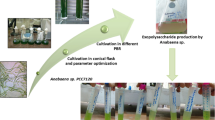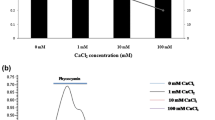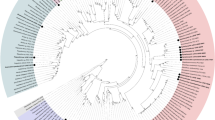Abstract
Bioflocculant exopolysaccharide (EPS) production by 40 cyanobacterial strains during their photoautotrophic growth was investigated. Highest levels of EPS were produced by Nostoc sp. BTA97 and Anabaena sp. BTA990. EPS production was maximum during stationary growth phase, when nitrogenase activity was very low. Maximum EPS production occurred at pH 8.0 in the absence of any combined nitrogen source. The cyanobacterial EPS consisted of soluble protein and polysaccharide that included substantial amounts of neutral sugars and uronic acid. The EPS isolated from Anabaena sp. BTA990 and Nostoc sp. BTA97 demonstrated high flocculation capacity. There was a positive correlation between uronic acid content and flocculation activity. The flocculant bound a cationic dye, Alcian Blue, indicating it to be polyanionic. The 16S rRNA gene sequences for Nostoc sp. BTA97 and Anabaena sp. BTA990 were deposited at NCBI GenBank, and accession numbers were obtained as KJ830951 and KJ830948, respectively. The results of these experiments indicate that strains Anabaena sp. BTA990 and Nostoc sp. BTA97 are good candidates for the commercial production of EPS and might be utilized in industrial applications as an alternative to synthetic and abiotic flocculants.





Similar content being viewed by others
References
Flaibani, A., Olsen, Y., & Painter, T. J. (1989). Polysaccharides in desert reclamation: composition of exocellular proteoglycan complexes produced by filamentous blue green and unicellular green edaphic algae. Carbohydrate Research, 190, 235–248.
De Philippis, R., Margheri, M. C., Materassi, R., & Vincenzini, M. (1998). Potential of unicellular cyanobacteria from saline environments as exopolysaccharide producers. Applied and Environmental Microbiology, 64, 1130–1132.
De Philippis, R., Sili, C., Paperi, R., & Vincenzini, M. (2001). Exopolysaccharide-producing cyanobacteria and their possible exploitation: a review. Journal of Applied Phycology, 13, 293–299.
Ozturk, S., Aslim, B., & Suludere, Z. (2009). Evaluation of chromium (VI) removal behaviour by two isolates of Synechocystis sp. in terms of exopolysaccharide (EPS) production and monomer composition. Bioresource Technology, 100, 5588–5593.
Bender, J., & Phillips, P. (2004). Microbial mats for multiple applications in aquaculture and bioremediation. Bioresource Technology, 94, 229–238.
Freire-Nordi, C. S., Vieira, A. A. H., & Nascimento, O. R. (2005). The metal binding capacity of Anabaena spiroides extracellular polysaccharide: an EPR study. Process Biochemistry, 40, 2215–2224.
Ozturk, S., & Aslim, B. (2008). Relationship between chromium (VI) resistance and extracellular polymeric substances (EPS) concentration by some cyanobacterial isolates. Environmental Science and Pollution Research International, 15, 478–480.
Liu, Y., Lam, M. C., & Fang, H. P. (2001). Adsorption of heavy metals by EPS of activated sludge. Water Science and Technology, 43, 59–66.
Guibaud, G., Van Hullebusch, E., Bordas, F., Abzac, P., & Joussein, E. (2009). Sorption of Cd(II) and Pb(II) by exoplymeric substance (EPS) extracted from activated sludges and pure bacterial strains: modeling of the metal/ligand ratio effect and role of the mineral fraction. Bioresource Technology, 100, 2959–2968.
Guibaud, G., Van Hullebusch, E., & Bordas, F. (2006). Lead and cadmium biosorption by extracellular polymeric substances (EPS) extracted from activated sludges: pH-sorption edge tests and mathematical equilibrium modeling. Chemosphere, 64, 1955–1962.
Zhang, D. Y., Wang, J. L., & Pan, X. L. (2006). Cadmium sorption by EPS produced by anaerobic sludge under sulphate-reducing conditions. Journal of Hazardous Materials, 138, 589–593.
Comte, S., Guibaud, G., & Baudu, M. (2006). Biosorption properties of extracellular polymeric substances (EPS) resulting from activated sludge according to their type: soluble or bound. Process Biochemistry, 41, 815–823.
Zumriye, A. (2005). Application of biosorption for the removal of organic pollutants: a review. Process Biochemistry, 40, 997–1026.
Zhang, Z. Q., Xia, S. Q., Wang, X. J., Yang, A. M., Xu, B., Chen, L., Zhu, Z. L., Zhao, J. F., Nicole, J. R., & Didier, L. (2009). A novel biosorbent for dye removal: extracellular polymeric substance (EPS) of Proteus mirabilis TJ-1. Journal of Hazardous Materials, 163, 279–284.
Stanier, R. Y., Kunisawa, R., Mandel, M., & Cohen-Baziere, G. (1971). Purification and properties of unicellular blue-green algae (order Chroococcales). Bacteriological Reviews, 35, 171–205.
Plude, J. L., Parker, D. L., Schommer, O. J., Timmerman, R. J., Hagstrom, S. A., Joers, J. M., & Hnasko, R. (1991). Chemical characterization of polysaccharide from the slime layer of the cyanobacterium Microcystis flosaquae C3-40. Applied and Environmental Microbiology, 57, 1696–1700.
Klock, J. H., Weiland, A., Seifert, R., & Michaeli, W. (2007). Extracellular polymeric substances (EPS) from cyanobacterial mats: characterization and isolation method optimization. Marine Biology, 152, 1077–1085.
Spiro, R. G. (1966). Analysis of sugars found in glycoproteins. Methods in Enzymology, 8, 3–26.
Herbert, T. D., Phipps, P. J., & Strange, R. E. (1971). Chemical analysis of microbial cells. In J. R. Morris & D. W. Ribbon (Eds.), Methods of microbiology (pp. 209–234). NY: Academic.
Galambos, J. T. (1967). The reaction of carbazole with carbohydrates. 1. Effect of borate and sulfamate on the carbazole color of sugars. Analytical Biochemistry, 19, 119–132.
Bar-or, Y., & Shilo, M. (1987). Characterization of macromolecular flocculants produced by Phormidium sp. strain J and by Anabaenopsis circularis PCCC 6720. Applied and Environmental Microbiology, 53, 2226–2230.
Hardy, R. F. W., Burns, R. L., & Holsten, R. D. (1973). Applications of the acetylene reduction assay for measurement of nitrogen fixation. Soil Biology and Biochemistry, 5, 47–81.
Avijeet, S. O., Oinam, G., Singh, K. O., & Tiwari, O. N. (2013). Isolation of fresh water cyanobacterial DNA of north east India by modified xanthogenate method. International Journal of Research in BioSciences, 2(2), 75–82.
Nubel, U., Garcia-Pichel, F., & Muyzer, G. (1997). PCR primers to amplify 16S rRNA gene from cyanobacteria. Applied and Environmental Microbiology, 63(8), 3327–3332.
Thompson, J. D., Higgins, D. G., & Gibson, T. J. (1994). CLUSTAL W: improving the sensitivity of progressive multiple sequence alignment through sequence weighting, position-specific gap penalties and weight matrix choice. Nucleic Acids Research, 22, 4673–4680.
Tamura, K., Dudley, J., Nei, M., & Kumar, S. (2007). MEGA4: Molecular Evolutionary Genetics Analysis (MEGA) software version 4.0. Molecular Biology and Evolution, 24, 1596–1599.
Desikachary, T. V. (1959). Cyanophyta. New Delhi: Indian Council of Agricultural Research.
Otero, A., & Vincenzini, M. (2003). Extracellular polysaccharide synthesis by Nostoc strains as affected by N source and light intensity. Journal of Biotechnology, 102, 143–152.
Jindal, N., Singh, D. P., & Khattar, J. S. (2011). Kinetics and physico-chemical characterization of exopolysaccharides produced by the cyanobacterium Oscillatoria formosa. World Journal of Microbiology and Biotechnology, 27, 2139–2146.
Khattar, J. S., Singh, D. P., Jindal, N., Kaur, N., Singh, Y., Rahi, P., & Gulati, A. (2010). Isolation and characterization of exopolysaccharides produced by the cyanobacterium Limnothrix redekei PUPCCC 116. Applied Biochemistry and Biotechnology, 162, 1327–1338.
Nicolaus, B., Panico, A., Lama, L., Romano, I., Manca, M. C., De Giulio, A., & Gambacorta, A. (1999). Chemical composition and production of exopolysaccharides from representative members of heterocystous and non-heterocystous cyanobacteria. Phytochemistry, 52, 63–647.
Singh, S., & Das, S. (2011). Screening, production, optimization and characterization of cyanobacterial polysaccharide. World Journal of Microbiology and Biotechnology, 27, 1971–1980.
Mota, R., Guimaraes, R., Buttel, Z., Rossi, F., Colica, G., Silva, C. J., Santos, C., Gales, L., Zille, A., De Philippis, R., Pereira, S. B., & Tamaqnini, P. (2013). Production and characterization of extracellular carbohydrate polymer from Cyanothece sp. CCY 0110. Carbohydrate Polymers, 92, 408–1415.
Raus Madieldo, P., & De Los Reyes Gavilan, C. G. (2005). Invited review: methods for the screening, isolation and characterization of exopolysaccharides produced by lactic acid bacteria. Journal of Dairy Science, 88, 843–856.
Sutherland, I. W. (1994). Structure-function relationships in microbial exopolysaccharides. Biotechnology Advances, 12, 393–448.
Ohki, K., Nguyen, Q. T., Yoshikawa, S., Kanesaki, Y., Okajima, M., Kaneko, T., & Tran, H. T. (2014). Exopolysaccharide production by a unicellular freshwater cyanobacterium Cyanothece sp. isolated in a rice field of Vietnam. Journal of Applied Phycology, 26(1), 265–272.
De Philippis, R., Colica, G., & Micheletti, E. (2011). Exopolysaccharide-producing cyanobacteria in heavy metal removal from water: molecular basis and practical applicability of the biosorption process. Applied Microbiology and Biotechnology, 92, 697–708.
Fattom, A., & Shilo, M. (1984). Phormidium J-1 bioflocculant: production and activity. Archives of Microbiology, 139, 421–426.
Bender, J., Rodriguezeaton, S., Ekanemesang, U. M., & Phillips, P. (1994). Characterization of metal-binding bioflocculants produced by the cyanobacterial component of mixed microbial mats. Applied and Environmental Microbiology, 60, 2311–2315.
Kroen, W. K., & Rayburn, W. R. (1984). Influence of growth status and nutrients on extracellular polysaccharides synthesis by the soil alga Chlamydomonas mexicana (Chlorophyceae). Journal of Phycology, 20, 253–257.
Moreno, J., Vargas, M. A., Madiedo, J. M., & Munoz, J. (2000). Chemical and rheological properties of an extracellular polysaccharide produced by the cyanobacterium Anabaena sp. ATCC 333047. Biotechnology and Bioengineering, 67, 283–290.
West, T. P. (2000). Exopolysaccharide production by entrapped cells of the fungus Aureobasidium pullulans ATCC 201253. Journal of Basic Microbiology, 40, 397–401.
West, T. P. (2011). Effect of carbon source on polysaccharide production by alginate-entrapped Aureobasidium pullulans ATCC 42023 cells. Journal of Basic Microbiology, 51, 673–677.
Kumar, C. G., Joo, H., Kavali, R., & Choi, J. (2004). Characterization of an extracellular biopolymer flocculant from a haloalkalophilic Bacillus isolate. World Journal of Microbiology and Biotechnology, 20, 833–836.
De Philippis, R., & Vincenzini, M. (1998). Exocellular polysaccharides from cyanobacteria and their possible applications. FEMS Microbiology Reviews, 22, 151–175.
Kumar, A. S., Mody, K., & Jha, B. (2007). Bacterial exopolysaccharides: a perception. Journal of Basic Microbiology, 47, 103–117.
Jindal, N., Singh, D. P., & Khattar, J. S. (2013). Optimization, characterization, and flow properties of exopolysaccharides produced by the cyanobacterium Lyngbya stagnina. Journal of Basic Microbiology, 53, 902–912.
Shah, V., Garg, N., & Madamwar, D. (1999). Exopolysaccharide production by a marine cyanobacterium Cyanothece sp.: application in dye removal by its gelation phenomenon. Applied Biochemistry and Biotechnology, 82, 81–90.
Parikh, A., & Madamwar, D. (2006). Partial characterization of extracellular polysaccharides from cyanobacteria. Bioresource Technology, 97, 1822–1827.
Trabelsi, L., Msakni, N., Ouada, H. B., Bacha, H., & Roudesli, S. (2009). Partial characterisation of extracellular polysaccharides produced by cyanobacterium Arthrospira platensis. Biotechnology and Bioprocess Engineering, 14, 1407–1415.
Zhang, Z., Bo, L., Xia, S., Wang, X., & Yang, A. (2007). Production and application of a novel bioflocculant by multiple-microorganism consortia using brewery wastewater as carbon source. Journal of Environmental Sciences, 19(6), 667–673.
Yim, J. H., Kim, S. J., Ahn, S. H., & Lee, H. K. (2007). Characterization of a novel bioflocculant, p-KG03, from a marine dinoflagellate, Gyrodinium impudicum KG03. Bioresource Technology, 98, 361–367.
Pereira, S., Zille, A., Micheletti, E., Moradas-Ferreira, P., De Philippis, R., & Tamagnini, P. (2009). Complexity of cyanobacterial exopolysaccharides: composition, structures, inducing factors and putative genes involved in their biosynthesis and assembly. FEMS Microbiology Reviews, 33, 917–941.
Phlips, E. J., Zeman, C., & Hansen, P. (1989). Growth, photosynthesis, nitrogen fixation and carbohydrate production by a unicellular cyanobacterium Synechococcus sp. (cyanophyta). Journal of Applied Phycology, 1, 137–145.
Fresnedo, O., & Serra, J. L. (1992). Effect of nitrogen starvation on the biochemistry of Phormidium laminosum (Cyanophyceae). Journal of Phycology, 28, 786–793.
Sangar, V. K., & Dugan, P. R. (1972). Polysaccharide produced by Anacystis nidulans: its ecological implication. Applied Microbiology, 24, 732–734.
De Philippis, R., Margheri, M. C., Pelosi, E., & Ventura, S. (1993). Exopolysaccharide production by a unicellular cyanobacterium isolated from a hypersaline habitat. Journal of Applied Phycology, 5, 387–394.
Tischer, R. G., & Davis, E. B. (1971). The effect of various nitrogen sources upon the production of extracellular polysaccharide by the blue-green alga Anabaena flosaquae A-37. Journal of Experimental Botany, 22, 546–551.
Herrero, A., Muro-Pastor, A., & Flores, E. (2001). Nitrogen control in cyanobacteria. Journal of Bacteriology, 183, 411–425.
Li, P., Harding, S. E., & Liu, Z. (2001). Cyanobacterial exoplysaccharides: their nature and potential biotechnological applications. Biotechnology and Genetic Engineering, 18, 375–404.
Bajaj, I. B., Lele, S. S., & Singhal, R. S. (2009). A statistical approach to optimisation of fermentive production of poly (gamma glutamic acid) from Bacillus licheniformis NCIM 2324. Bioresource Technology, 100, 826–832.
Ramus, J. (1977). Alcian-blue: a quantitative aqueous assay for algal acid and sulfated polysaccharides. Journal of Phycology, 13, 345–348.
Smith, R. W., & Miettinen, M. (2006). Microorganisms in flotation and flocculation: future technology or laboratory curiosity? Minerals Engineering, 19, 548–553.
Acknowledgments
The authors are thankful to the Director, IBSD, Imphal, Manipur, India for providing laboratory facilities and Dr. Yogesh S. Shouche, Scientist, MCC-NCCS, Pune for scientific input in the present manuscript and the Department of Biotechnology, Government of India for financial assistance (vide grant no. BT/218/NE/TBP/2011).
Author information
Authors and Affiliations
Corresponding author
Electronic supplementary material
Below is the link to the electronic supplementary material.
ESM 1
(DOC 1117 kb)
Rights and permissions
About this article
Cite this article
Tiwari, O.N., Khangembam, R., Shamjetshabam, M. et al. Characterization and Optimization of Bioflocculant Exopolysaccharide Production by Cyanobacteria Nostoc sp. BTA97 and Anabaena sp. BTA990 in Culture Conditions. Appl Biochem Biotechnol 176, 1950–1963 (2015). https://doi.org/10.1007/s12010-015-1691-2
Received:
Accepted:
Published:
Issue Date:
DOI: https://doi.org/10.1007/s12010-015-1691-2




